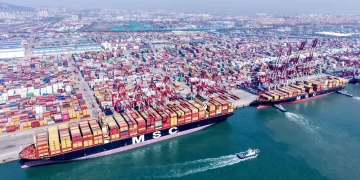Introduction
In the second quarter of 2025, Southeast Asia experienced an extraordinary surge in mobile payment adoption, with user numbers increasing by 35%. This rapid digital payment growth is reshaping financial habits and expanding access to financial services across the region. Yet, intriguingly, this expansion coincided with a sharp rise in defaults within China’s shadow banking sector—particularly in peer-to-peer (P2P) lending—reaching the highest levels since 2020. This simultaneity poses a pressing question: Why did Southeast Asia’s booming mobile payment ecosystem grow alongside escalating shadow banking risks in China?
This juxtaposition reflects an increasingly complex financial landscape in the Asia-Pacific region. On one hand, Southeast Asia’s digital finance revolution signals financial inclusion, technological progress, and new capital flows. On the other, China’s shadow banking uncertainties risk unsettling regional stability by affecting cross-border capital movements and investor confidence. Understanding this paradox requires a close look at data trends, market interconnections, and diverse expert interpretations.
Key Data and Background
The 35% increase in mobile payment users in Southeast Asia during Q2 2025 represents a continuation of an accelerated digital finance adoption trend that began post-pandemic. Countries like Indonesia, Vietnam, and the Philippines have seen mobile wallets, QR code payments, and digital banking apps become mainstream, driven by smartphone penetration, fintech innovations, and supportive regulatory frameworks. According to data from the Asia Mobile Financial Association, the total transaction volume via mobile payments in these markets exceeded $250 billion in Q2 alone.
Simultaneously, China’s shadow banking sector—comprising non-bank financial institutions, P2P platforms, and off-balance-sheet lending—has faced mounting pressure. Default rates for P2P lenders in China surged to 7.2% in Q2 2025, the highest since regulatory crackdowns intensified in 2020. The People’s Bank of China (PBOC) reported tighter oversight and slower credit growth, reflecting systemic risks including liquidity stress and borrower defaults. These developments highlight unresolved challenges in China’s credit markets despite official reforms.
(See Figure 1: Southeast Asia Mobile Payment User Growth vs. Chinese Shadow Banking Default Rates, Q1 2020–Q2 2025)
The backdrop includes regional monetary policy shifts. Southeast Asian central banks continued easing policies to stimulate growth, while China’s regulators adopted a more cautious stance, aiming to balance economic recovery with financial risk containment. This policy divergence shaped capital flows and investor sentiment across the region.
Cross-Market Impact
The simultaneous surge in Southeast Asia’s mobile payments and rise in Chinese shadow banking risks created notable cross-market dynamics.
Firstly, Southeast Asia’s digital financial expansion attracted significant capital inflows, including investments from China seeking alternative growth avenues amid domestic credit tightening. These inflows bolstered fintech startups and digital infrastructure but also introduced risks related to capital flight and asset bubbles in the emerging tech sector.
Meanwhile, traditional banks in Southeast Asia faced pressure as consumers and small businesses increasingly preferred digital wallets over conventional banking services. This shift prompted some banks to innovate rapidly but also exposed vulnerabilities, especially for institutions slow to adapt.
China’s shadow banking instability also disrupted regional capital markets. Investor caution led to tighter liquidity conditions, particularly affecting offshore RMB lending and trade finance. Countries with strong trade links to China, such as Malaysia and Thailand, saw increased market volatility. This scenario mirrored the 2013 “taper tantrum,” when U.S. Federal Reserve policy shifts triggered capital outflows from emerging Asia, though the current episode differs in that it stems from internal Chinese credit stresses rather than external policy changes.
Cross-border regulatory coordination emerged as a key theme. ASEAN regulators and Chinese authorities engaged in dialogue to mitigate contagion risks, balancing openness with prudential safeguards.

Expert Viewpoints and Contrasting Opinions
Financial authorities and analysts offer divergent perspectives on this complex interplay.
The Monetary Authority of Singapore (MAS) emphasizes the positive role of digital payments in enhancing financial inclusion and economic resilience. MAS reports suggest that mobile payments lower transaction costs and bring unbanked populations into the formal financial system. They argue that these benefits outweigh short-term volatility risks, urging continued innovation under strong regulatory frameworks.
Conversely, the Asian Economic Research Institute (AERI) warns that China’s shadow banking risks represent a systemic threat to regional financial stability. Their analysis highlights contagion risks via interbank markets and cross-border financing, cautioning that mobile payment surges could mask underlying fragilities. AERI advocates for enhanced transparency and risk monitoring to prevent destabilizing spillovers.
Some institutional investors align with MAS’s optimism, viewing Southeast Asia’s fintech growth as a long-term investment opportunity. Yet others echo AERI’s concerns, noting that underappreciated credit risks in China may trigger abrupt market corrections, similar to past crises.
Adding depth, Nobel laureate economists challenge traditional models that assume markets efficiently price systemic risks. They argue that social and technological disruptions can decouple market sentiment from underlying fundamentals, complicating risk assessment.
Future Outlook and Strategies
Looking ahead, three broad scenarios characterize the evolving landscape.
In an optimistic scenario, Southeast Asia’s mobile payment ecosystem continues expanding smoothly, driven by regulatory innovation, increasing consumer adoption, and regional economic growth. Concurrently, China’s shadow banking sector stabilizes through reforms, reducing spillover risks and fostering greater regional financial integration.
A pessimistic scenario envisions worsening shadow banking defaults sparking broader credit market stress. Capital flight from China could accelerate, causing liquidity crunches and undermining Southeast Asia’s fintech momentum. Traditional banks might face solvency challenges, and regional markets could enter prolonged volatility.
A middle-ground scenario anticipates episodic turbulence but overall growth. Policymakers prioritize cross-border cooperation and implement robust risk frameworks. Investors remain cautious but engaged, leveraging data analytics and scenario planning.
For investors and stakeholders, actionable steps include:
- Tracking key credit risk indicators in China alongside fintech adoption metrics in Southeast Asia.
- Diversifying portfolios to balance exposure between digital financial innovation and traditional credit risk.
- Monitoring regulatory developments and participating in multi-jurisdictional dialogues on financial stability.
These strategies can help navigate a rapidly evolving regional financial ecosystem marked by both opportunity and risk.
Conclusion
The 2025 Q2 surge in Southeast Asia’s mobile payments against the backdrop of rising Chinese shadow banking risks illustrates a dual narrative of technological progress and financial uncertainty. While digital finance is driving inclusion and growth, unresolved credit risks in China pose tangible challenges to regional stability. This tension underscores the need for nuanced analysis, coordinated policy responses, and adaptive investment strategies.
The pressing question remains: How will Southeast Asia’s digital financial revolution evolve amid the shadow of Chinese credit uncertainties, and what mechanisms will ensure that innovation does not come at the cost of systemic risk?

































